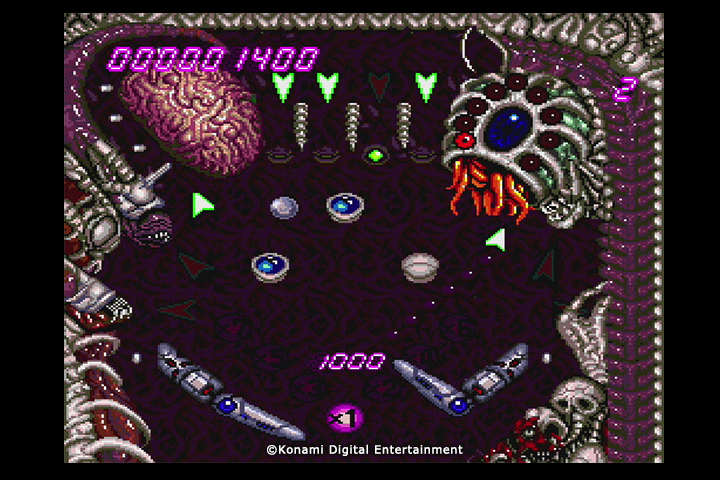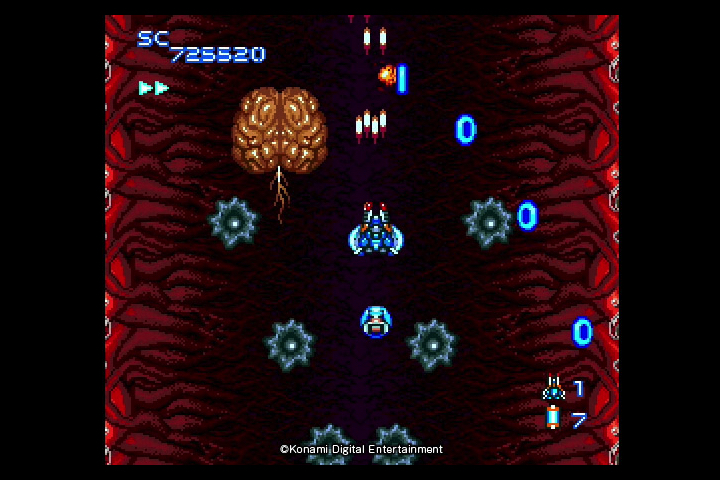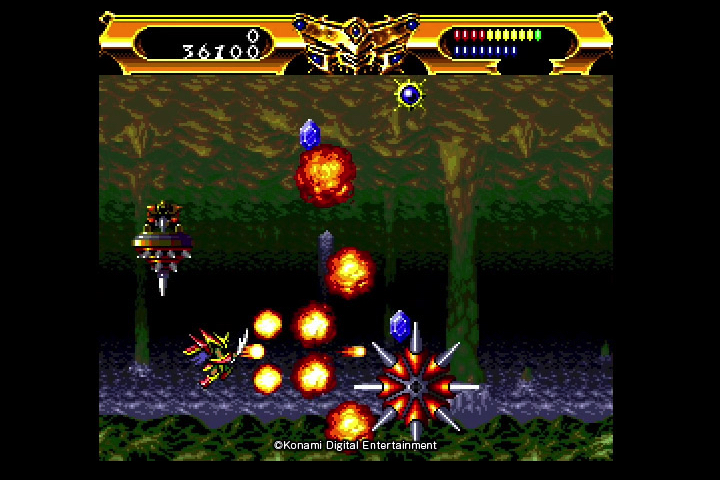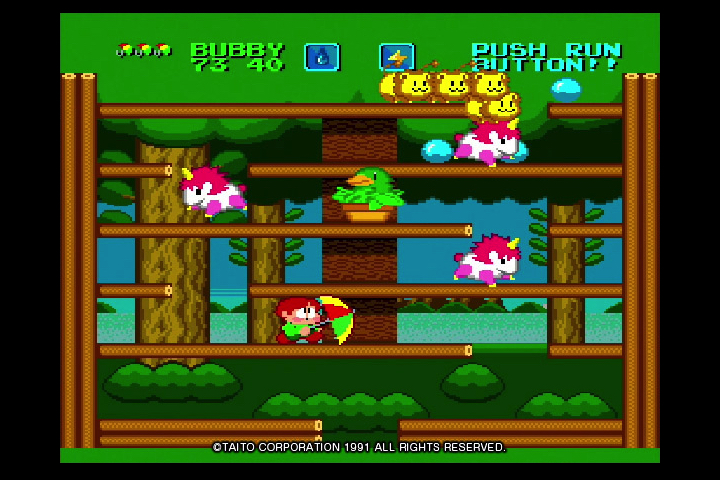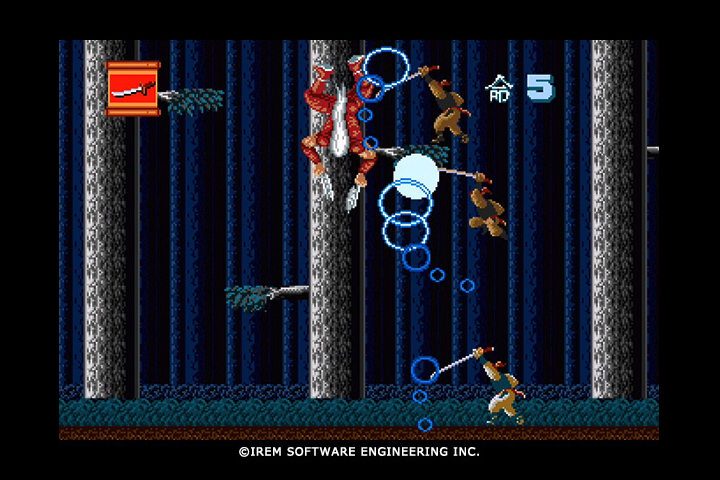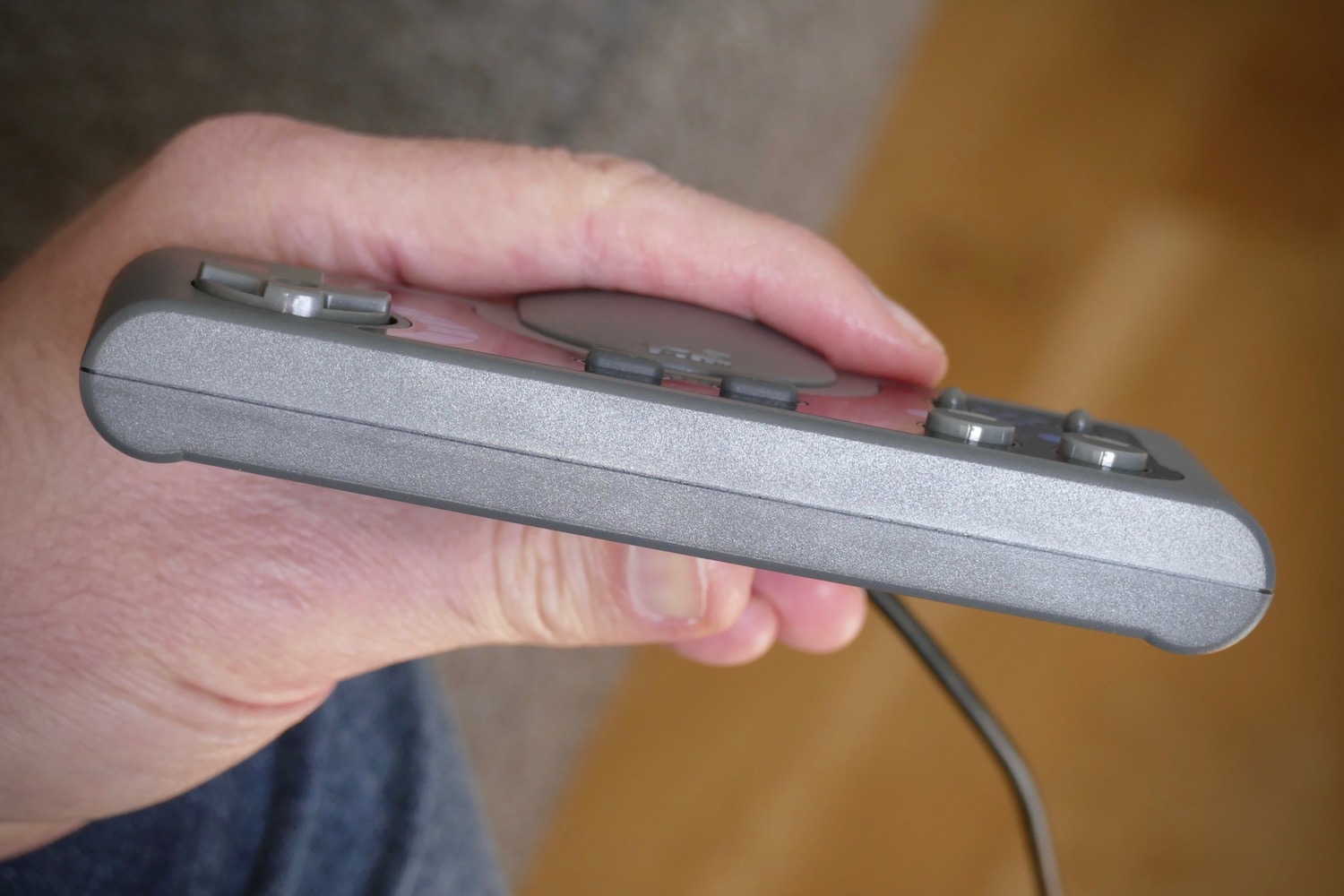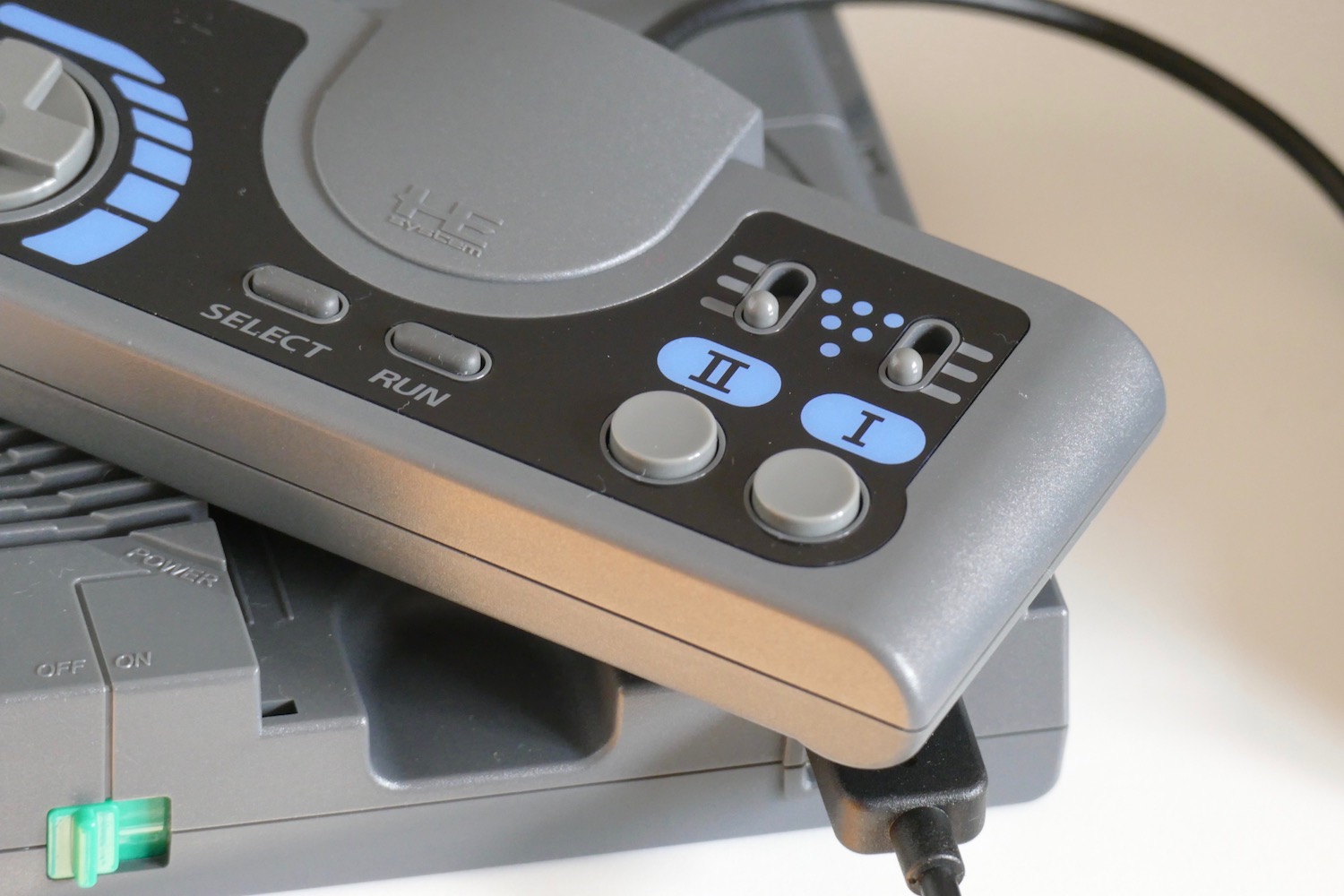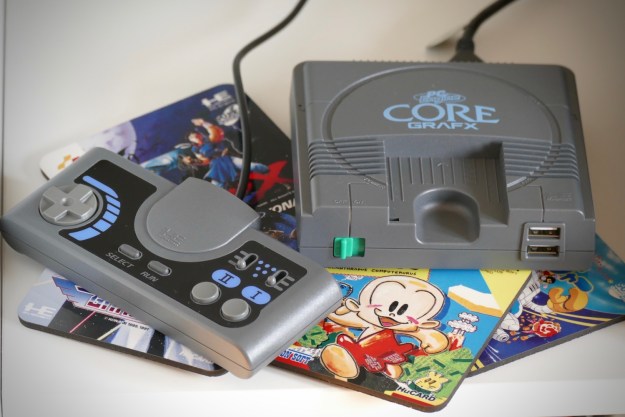
“Beautifully presented with a super software and gaming experience, the TurboGrafx-16 Mini is the latest must-have retro console.”
- Affordable price
- Beautifully crafted hardware and software
- Extensive game selection
- Optional multiplayer support
- Second controller not included
- Quirky games may limit wide appeal
Do you think you’re a hardcore gamer? Do you usually complete the video games you play in a couple of sittings and snicker when a friend calls a game a “challenge” after you’ve already beaten it several times? If that’s you, then it’s time to put your money where your mouth is and buy the TurboGrafx-16 Mini, which is home to some of the toughest games ever created.

The TurboGrafx 16 Mini, known as the PC Engine Mini in Japan and the Core Grafx Mini in Europe, is another entry into the popular world of rereleased retro gaming consoles, and toughness aside, it’s a little box of joy. I spent a long weekend dipping in and out of it to see what it’s like.
Design and setup
The model you see here is the European Core Grafx Mini, which re-creates the original model exactly, except for a 10% reduction in scale. The TurboGrafx 16 Mini is also a faithful re-creation of the ’90s original, but differs greatly in its look. The little console is made from plastic and is very lightweight. On the front are two USB Type-A ports to plug in the controller. One comes in the box, but you can buy additional controllers, plus an adapter to add up to five controllers for some of the games. This is a bit of a shame, as there are some great two-player titles included here, and paying extra on top of the $100 price will put some people off trying them.

On the back is a removable plate that hides the HDMI connector for your television, as well as a Micro-USB for power. You get a cable in the box but no power adapter. I used a basic charger that came with an Apple iPhone, and it worked without a problem, so you don’t need to go out and buy a special one before using the console. Back on the front, there is a power switch in the same place as the original.
It takes just a few moments to plug the console in and flick the switch, at which time it’s instantly ready to go. There’s no waiting around, no internet connection to set up, and no profile to create. It’s a welcome change from some of the more complex games consoles out there and makes the Core Grafx Mini perfect for a quick gaming fix.

The two-button controller is the same size and design as the original, and has rapid-fire switches for both buttons. It’s smaller than a PlayStation 4 Dual Shock controller and much lighter. It’s comfortable to hold and use, and is attached to a generous 10-foot (3 meter) cable, but anyone who has only used a modern controller will find it basic. The D-pad is less precise than an analog stick or even a touchscreen, and it feels cramped at first due to the small size, though I became used to it after a short while. All this is part of the appeal, true to the original, and representative of its time. It’s also a reason why the lineup of games will test your ability.
Menu and game selection
What a beautifully designed software and menu system this console offers. From the different wallpapers — the animated one with the PC Engine character running around is best — to the cheerful stereo music, and the simplicity of game selection, it’s both lovingly created and perfectly executed. You scroll through a horizontal list of games, which are broken down by console. This means you get a choice of games released on the TurboGrafx 16 and on the PC Engine in Japan.
Select a game and you get a cool animation of the Hu-Card or CD ROM being “inserted” into the virtual console, complete with spot-on sound effects. It’s this care and attention that will make those who played on the original smile. This continues when you dig into the settings menu, as you can opt to play your game as if it was viewed on the handheld version of the PC Engine. There’s a 4:3 aspect ratio CRT filter for added retro realism as well.
How about the games? There are 57 games preinstalled, and the list includes most genres, with a focus on shooters, platform games, arcade ports, and RPGs. There are various PC Engine exclusive titles, and 32 PC Engine games in the original Japanese language. This can make it a bit of a challenge getting into some of the more complex games, but most games are straightforward to learn and play. This was before the time of on-screen guides, complicated control methods, or multi-button movement mechanics, so you will have to experiment quite often in some games to figure out what to do when instructions aren’t provided.
Playing games
Here are a few things you really need to know about playing PC Engine games: Some are quite weird, there are a lot of shoot-em-ups, you likely won’t have played many of the titles before, and almost all are really hard. I owned a PC Engine shortly after it was released in Japan, so some of the titles were familiar, and it’s those I started out with to ease myself back into PC Engine gaming again.

When I bought the PC Engine originally, I did so for a shoot-em-up known as Gunhed, or Blazing Lazers internationally. It’s here, and it’s every bit as much fun as it was back then. It scrolls vertically, has a cool array of upgradable weapons, a memorable soundtrack, and some tough enemies. This sets the tone for most games on the console. However, it’s not the only shooter I played on the new console, and it turns out it’s a treasure trove of insane shoot-em-ups.
Soldier Blade and Super Star Soldier are very similar to Blazing Lazers, and among many others, they’re joined by the intense, Super CD ROM exclusive title Ginga Fukei Densetsu Sapphire. Don’t let the first few relatively simple levels of Soldier Blade fool you. It gets really hard, really quickly, but it’s got nothing on Ginga Fukei Densetsu Sapphire. I hadn’t played this before, but it immediately and totally owned me. It is so insanely difficult, so impossibly hard, that it makes you giggle when your ship gets blown up again. It does this a lot, which got old pretty quickly, and made Soldier Blade and Super Star Soldier more fun to play.
Massively difficult shooters are common here. Dragon Spirit has both land and sky enemies to fry. Fantasy Zone lets you move both left and right through a landscape (a crazy world that’s like a spin on The Beatles’ Yellow Submarine movie, just with bullets) where enemies fire from all directions. Psychosis lives up to its name because the ship doesn’t move quite as quickly as you want it to, so you get overwhelmed in moments. What’s interesting is that I don’t mind trying the games again and again, because the challenge is welcome and still rather fun.
What else? I love the pinball game Alien Crush, the Bubble Bobble-style Parasol Stars, and PC Engine classic Ninja Spirit. Yes, it’s also difficult, but it’s achievable due to the mega-weaponry and a steep but sensible learning curve. Arcade game Space Harrier is there, along with R-Type, plus all the best Bomberman games including Bomberman Panic Bomber, an excellent Tetris/Candy Crush-style mashup.
What about the weirdness? There’s plenty of that. Probably the best is Lords of Thunder, a barking mad sideways scrolling shooter straight from the imagination of an ’80s teenage metalhead. There’s a hair metal guitar soundtrack, a Thor-like character, and a high level of difficulty. Then there’s J.J. and Jeff, an odd platformer with pooping birds and a farting hero, plus other odd but really fun platform games like Air Zonk, PC Genjin, and Bonk’s Revenge. Make sure you check out the Japanese-language sports game Appare! Gateball, which is a bit like croquet and way more fun than it sounds.
There are hours and hours of entertainment inside this little console. The games above kept me occupied for ages over a weekend, and all this is before digging into some of the longer RPG games like Neutopia and Neutopia 2. Just be aware that none of these games are easy. Whether its the control method, the mechanics, or the game design itself, you absolutely will be challenged by many of the games here. Naturally, some are frustrating because of this, but not that many. The best titles are fair and well designed, so you rarely feel like you couldn’t get further with just a bit more practice.

The list of quirky titles and ultra-hard gameplay may not appeal to anyone who has never played games from this era, or heard of the PC Engine before. It’s probably the least mainstream of the retro consoles out there. I was familiar with it and several of the games, so I went in knowing what it was going to be like. This isn’t to say you shouldn’t get one, just do so knowing it’s a little bit different.
Sadly, I didn’t get the chance to try out the multiplayer mode on the console this time, but did so when I saw an early version at the beginning of 2020. Playing Bomberman against a real-life opponent is ridiculously enjoyable, and if you’ve got like-minded friends, investing in a second controller will add to the longevity on offer here.
Price, availability, and warranty
The TurboGrafx-16 Mini costs $100 through Amazon in the U.S., and 100 British pounds through Amazon in the U.K.. Although the console has been available for pre-order already, deliveries were delayed, and the dates are still up in the air. Konami has provided Digital Trends with the following statement on the shipping and release status:
“We’re working closely with Amazon to provide regular updates to our customers that have pre-ordered the PC Engine Core Grafx Mini and TurboGrafx-16 Mini. For the latest information on the delivery date, please check the ‘Track Your Package’ page on Amazon. Amazon is still accepting new pre-orders for the consoles and we’re working hard to resume normal delivery schedules as soon as possible. We thank everyone for their patience during this uncertain time.”
Our Take
Reincarnated from a time when games took no prisoners, the TurboGrafx-16 Mini’s wonderful roster of games means if one title is too tough, another is waiting to entice you. It’s not just retro fans who will appreciate the console, but fans of shoot-em-ups as well, thanks to the extensive list of real classics on board. Lovingly crafted software, simple setup, and a decent price makes this mini console accessible to everyone.
Is there a better alternative?
No. If you want to play TurboGrafx-16 and PC Engine games, there aren’t many other opportunities to do so outside of tracking down an original console and buying games. However, if you just want a retro gaming experience and don’t mind what the console is, there are several other choices. The $80 Sega Genesis Mini will likely have a wider range of more familiar games to play, as will the $80 Nintendo SNES Classic, provided you can find one for sale.
How long will it last?
The console should withstand normal use without an issue, and even the controller should be fine even after one or two frustrated flings onto the ground. The list of games is extensive and varied, plus some are difficult to master, so there are many hours of entertainment to be had. The best thing about retro consoles like this is how quick they are to setup and use, so even in a couple of years, when the temptation to play strikes, it’ll be easy to have a quick go.
Should you buy one?
Yes, definitely. The generous list of games, as well as the slick software and design, make it easy to recommend.


